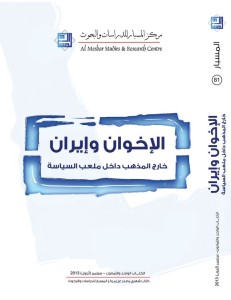In its 81st monthly book, Al-Mesbar Center continues its study of the relationship between Iran and the Muslim Brotherhood, which began in last month’s volume, Iran and the Brotherhood: Enlisting Religion for a Political Battle. That book tracked the history and politics of relations between the two, revealing the the points of intersection and divergence between the largest Islamist movements of the Sunni and Shi’ite sects. It also offered a preliminary assessment of the fate of Egypt’s Islamists following the June 30, 2013 ouster of Brotherhood-affiliated president Muhammad Morsi — as well as its present and potential future impact on the Brotherhood’s counterparts in Tehran. In the current volume, a diverse group of researchers tackle a new set of related questions.
Abd al-Ghani Imad, a Lebanese scholar specializing in Islamist movements, presents a study in comparative discourse in his paper, “Brotherhoodism and Khomeiniism: Comparison of Principal Political Concepts.” He delves into the meaning of the terms “Ummah,” the “state,” “state governance,” “citizenship,” the “other,” the “West,” and the “Arab-Israeli conflict,” as defined by the Islamists of Egypt and Iran. Having done so, he traces how the concepts evolved over time, and how the two Islamist movements affected each other’s understanding of them.
Next, Fatima al-Samadi, a Jordanian researcher on Iranian issues, presents “Islamists in Iran and Egypt, 1979-2011: Ideological Interplay.” Beginning with Brotherhood founding father Hasan al-Banna and Iranian Islamic revolutionary leader Ayatollah Ruhollah Khomeini, Samadi identifies points of agreement and difference between the two sides in terms of political thought on a broad range of issues: the relationship between religion and politics, envisioned forms of government, and the mechanics of legislation based on Shari’ah. She finds that despite the historical relationship between Islamists in Iran and Egypt, these ties were overshadowed by the dramatic events that have come to be known as the “Arab Spring revolutions.” Iran had expected that the new regimes which would follow the toppled secular dictatorships of Egypt and Tunisia would be modeled after Iranian Islamic revolutionary state-building. Yet their model was rejected — and Tehran, having viewed its regime as the great exemplar for all Muslim societies, grew disappointed. Meanwhile, Iranian support for Syrian president Bashar al-Asad caused a deep rift in the relationship between Iran and the newly empowered Sunni Islamists — a relationship on which Tehran had staked its plans and aspirations.
Kamal Hilbawi, Secretary General of the Islamic Unity Forum and former spokesman for the Muslim Brotherhood in the West, contributes the third paper. He traces relations between Iran and the Brotherhood from the latter’s founding by Hasan al-Banna in 1928 to the ouster of president Muhammad Morsi in 2013. Among Brotherhood elites, Hilbawi is regarded as one of the closest to the Iranian leadership. He begins his paper by warning of the “machinations” of some circles in the West which seek to foment discord between Iran and other Islamic countries. Hilbawi strives to demonstrate that Brotherhood founder Hasan al-Banna was deeply committed to Islamic unity — a view that was crystallized in his writings. Hilbawi documents Banna’s positions on Islamic sects and his calls for faith-based conflict resolution. He argues that such convictions held sway for decades to follow, noting the joy with which the Brotherhood greeted the nascent Islamic revolutionary state in 1979. The challenge of brokering Sunni-Shi’ite rapprochement figures prominently into the paper: He reveals Brotherhood leaders’ dilemmas in approaching the matter of rapprochement, and contends that they made great strides toward overcoming them. Testimony to this achievement, in his view, is the enhanced ties between the two movements respective leaderships which led to the creation of the “House of Conciliation Among Islamic Sects” (Dar al-Taqrib Bayn al-Madhahib al-Islamiya).
Comments on Hilbawi’s formulations are in turned presented by Yusuf al-Dini in his study, “The Brotherhood and Iran: Outside Sectarian Constraints and Inside the Cauldron of Politics.” The researcher criticizes Hilbawi’s argumentation, as part of a broader campaign on the part of the movement to cast itself as “moderate.” Dini finds, in sum, that the Brotherhood are not vanguards of rapprochement — and that the seemingly religious slogans of conciliation and unity are in reality a political agenda to establish a theocracy and confront any form of government that differs with it. Such is the Brotherhood’s core agenda, he argues, even if the movement makes the strategic choice to come to terms with the “Satanic” West.
The next paper, by Tunisian researcher Shukri al-Sayfi, examines the relationship between the Muslim Brotherhood and iran in three historical periods: (1) the Sunni Islamic awakening in 1980s; (2) the rise of the Shi’ites in Iraq after the fall of the Ba’th regime, and explosion of sectarian conflict; and (3), the period of the “Arab Spring” and its sectarian repercussions. Sayfi argues that the Islamic revolution in Iran represents “the first practical embodiment of the Islamist political project to build an Islamist state since the destruction of the Ottoman Empire.” Yet this goal had long been the dream of the Sunni Muslim Brotherhood.
Nabil al-Utum, a professor of Iranian studies at Balqa University in Jordan, strives in his study, “Iranian Perspectives on the January 25th Egyptian Revolution,” to answer two questions: First, did the Iranian Islamic Revolution influence the revolution in Egypt; and second, to what extent should the January 25, 2011 Egyptian revolution be regarded as an extension of the Khomeiniist revolution an embodiment of its goals?
Following Utum’s paper, the Egyptian researcher Maher Farghali tries in his study, “The Muslim Brotherhood and Iran: Penetration of the Egyptian Umma,” to scrutinize the goals of Iran as well as the Muslim Brotherhood in Egypt, with an eye to the dangers posed to Egypt by effective cooperation between the two. The writer demonstrates that the January 30 Egyptian revolution did not remove the Iranian threat posed to Egypt — to the contrary, in fact. Compounding the threat of Iran-Brotherhood cooperation in Egypt, the Brotherhood also poses a threat by virtue of its cooperation with Jihadist groups inside the country, which are keen to carry out armed attacks in response to the dismissal of Brotherhood rule.
Also in this volume, Al-Mesbar Center presents three additional reports: “Turkey and Its Policies in the Eyes of Americans and Europeans,” “Libya in the Eyes of the European Union,” and “European Policies Toward Libya.” The first of the three, prepared by American author Joseph Braude, assesses American policies toward Turkey with respect to six key issues: the Turkish economy, the crisis in Syria, the Kurdish issue, the Armenian question, attitudes toward the ruling Party of Justice and Development, and Turkish reactions to the transfer of power in Egypt last summer. For each topic, Braude also presents European perspectives in outline.
Italian researcher Arturo Farfili, in his report, assesses the positions of European countries toward Libya since the fall of the Gadhafi regime. He finds that the matter the most preoccupies decision makers in Europe with respect to Libya is the activity of Al-Qaeda in southern Libya, following the French intervention in Mali. Farfili, an expert in Italian-Libyan relations, finds that the policies of various European countries, while diverse, tend to converge around three axes: concerns about the future course of Libya’s elected government, the problem of restructuring and strengthening the Libyan armed forces, and the challenge of supporting Libyan state-building. The third and final report, which offers an evaluation of European policies toward Libya, highlights Europe’s most important interests with respect to Libya, as well as examples of European measures taken in the service of those interests.










